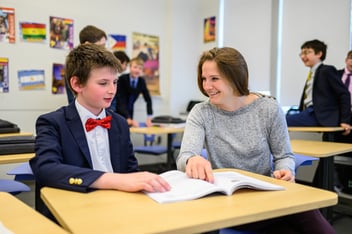Parenting advice columnist Melinda Wenner Moyer writes in Slate:
“I’ve avoided talking about race with my kids mainly because I’ve thought that racial bias is learned by direct instruction and imitation—and that if I don’t talk about race or act in explicitly racist ways, my kids won’t pick up prejudices. My sources told me that this notion is pretty common; research suggests that nonwhite parents talk about racial identity much more frequently with their kids than white parents do, but that even minority parents often avoid talking about racial differences.”
For young children, their natural curiosity leads them to ask questions, whether adults are comfortable answering them or not.
As a former elementary school librarian and science teacher and Fessenden's current Head of Lower School, Elizabeth Kiley has fielded her fair share of these questions. She has also witnessed countless interactions among the boys at The Fessenden School and has done her part to help the boys understand racial differences and the role of race in society in an open, positive way.
Elizabeth shared three lessons she has learned talking to boys, working with them, and teaching them about the complicated subject of race.
1. Young boys are very curious and they will ask questions.
As early as pre-kindergarten, Elizabeth says, boys are naturally observant, noting details and picking up differences quickly.

“They ask questions about race pretty readily,” Elizabeth says. “One common example is that boys often ask about skin color: ‘How did he get that skin color? ‘Why is he a different skin color?’”
Elizabeth has also observed that when boys ask these questions, adults are prone to panic. Boys pick up on this, too.
“They learn at a very young age that race can be something that is uncomfortable for adults, and therefore, we shouldn’t talk about it,” she notes.
Parents and educators need to learn to overcome their discomfort, Elizabeth says.
“It’s not racist to talk about race,” she says. “That’s something we really have to help our students and our children understand.”
As a former science teacher, Elizabeth prefers to take a scientific approach when students ask about racial differences. This resonates with the “little scientists” in elementary school.
“I often talk about the biological reasons why we have different skin colors. That’s pretty fascinating to boys,” she says. “It’s okay to be matter-of-fact about race because that’s really where they’re coming from. They’re just making observations and asking questions about what they see.”
As boys get older, Elizabeth has noticed, they start to move beyond simple observations and start connecting the differences they see among their peers and the people around them to the views of society at large. This happens around third or fourth grade. Boys begin placing themselves within a group of people with shared characteristics, trying to understand what it means to be a part of that group.
 At the same time, Elizabeth says, boys start to notice differences in other groups and become aware of the stereotypes that may exist about them. This is a critical time to expose those stereotypes for the myths they are, she explains.
At the same time, Elizabeth says, boys start to notice differences in other groups and become aware of the stereotypes that may exist about them. This is a critical time to expose those stereotypes for the myths they are, she explains.
For example, Elizabeth recounts, if she asks a class, “If somebody is brown, does that mean they’re really great at basketball?” the boys will immediately reply, “No, that’s ridiculous!”
“If you start giving them that language to say, ‘That’s a stereotype,’ Then they can start recognizing them and addressing them,” she says.
2. Boys have a natural sense of fairness.
One of the most powerful tools adults have for teaching young boys to react appropriately to racial issues is their inborn sense of justice.
“Children are all about fairness and understanding how something became unfair and understanding how they can help make a change,” Elizabeth says. “As soon as they are given permission to be agents of change, they latch right onto it. They really want to be somebody who helps make a change in the world that will lessen unfairness.”

This is why it’s so important to teach children—at an age-appropriate level—about the historical basis for racism. In third and fourth grade at Fessenden, Elizabeth says, boys learn about the historical circumstances that have caused racism.
“There’s a shift, and it’s an awesome shift because then they really understand, ‘That’s why that happened. Here’s what I can do to help keep that from happening again,’” she says. “They just need support from parents and teachers to do that because it’s innate within them.”
3. Young boys see the value in diversity.
In her experience, Elizabeth says, young children enjoy having a diverse range of backgrounds and worldviews around them. It makes their world a richer, more exciting place to experience.“It’s pretty amazing how quickly they latch on to the idea of diversity,” she observes. “Of course the world should be full of different people and different perspectives.”
Fessenden’s library helps nurture their students’ budding appreciation for diversity through the books they choose and the projects on which they work. Parents, too, can use literature to teach their children about diversity, Elizabeth says.
“I think it’s critical in sharing literature with children that you’re careful and conscious of what you’re sharing. Even if a story is fantastic, try to pick a different story that presents another perspective from what your child may be used to,” she says.

And if you need help selecting books that represent a wide range of perspectives, your elementary school librarian would be happy to make a few recommendations.
“Our librarians work pretty hard to create a collection that has breadth and depth here at Fessenden,” Elizabeth says. “They love working with parents to say, ‘Hey, that’s a really terrific story, but why don’t you try this one because it has the same flavor, tone, and humor, but it just has a different character?”
Inclusivity at Fessenden
By actively engaging in conversations about race and providing environments where diversity is celebrated, Fessenden aims to guide the next generation toward appreciating differences and removing biases. If this sounds like an environment you’d like your child to partake in, we encourage you to plan a visit to our campus or reach out to us for additional information.
Read On

Why ‘All-Boys’ Matters…and Why It’s Not Really ‘All Boys’

Can I Get There From Here? The Logistics of Transporting Multiple Children

